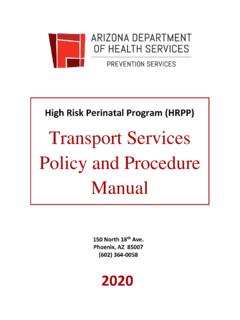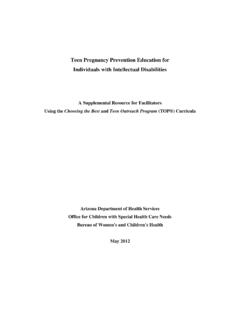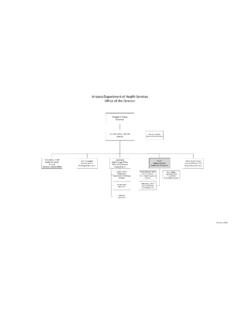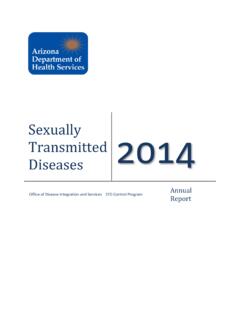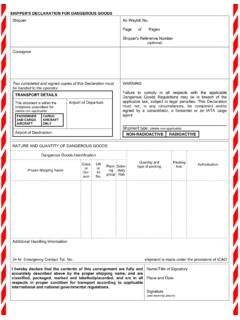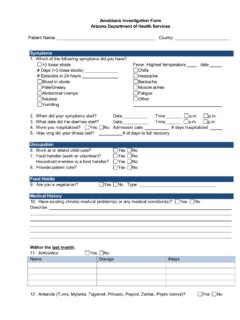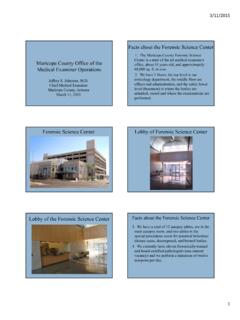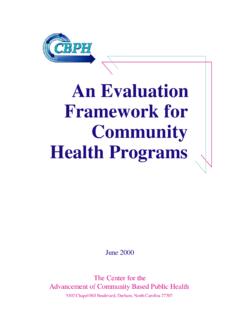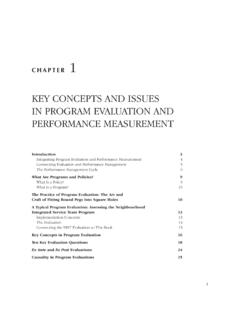Transcription of Program Evaluation Training Series: Evaluation Fundamentals
1 Program Evaluation Training Series: Evaluation Fundamentals RTI International for ADHS Bureau of Tobacco and Chronic Disease i Contents Section Page introduction 2 Program Evaluation Model 3 1. Engage your community .. 3 2. Plan your programs using data .. 3 3. Implement your programs .. 3 4. Gather data about your programs and participants .. 3 5. Report your findings to stakeholders .. 3 Process Evaluation and Outcome Evaluation 4 Process Evaluation .. 4 Outcome Evaluation .. 4 Quantitative and Qualitative Data 5 Appendices A Interview Protocol RTI International for ADHS Bureau of Tobacco and Chronic Disease 2 introduction RTI International is working on behalf of the Arizona Department of Health Services, Bureau of Tobacco and Chronic Disease (ADHS-BTCD) to conduct a short series of Evaluation -related trainings for partners.
2 The trainings will cover topics ranging from: 1. Using data to plan programming 2. Collecting focus group and survey data 3. Tracking community outreach 4. Conducting a process Evaluation and adapting evidence-based programs , policies, and practices (EBPPs) Each Training will incorporate general Program Evaluation Fundamentals that are included in this document. In addition, the trainings will incorporate Program and Evaluation details specific to ADHS-BTCD work. RTI International for ADHS Bureau of Tobacco and Chronic Disease * Adapted from CDC s introduction to Program Evaluation for Public Health programs : A Self-Study Guide Program Evaluation Model WHY DO IT?
3 One of several ways to answer How are we doing? There is no one right Evaluation . 1. Engage your community Reach out to understand your community s stakeholders and their needs 2. Plan your programs using data What are we doing and what should we be doing to achieve our goals? 3. Implement your programs Follow your action plan to implement your programs and adapt as necessary 4. Collect data to evaluate your programs and participants Use methods such as surveys or focus groups to gather specific information 5. Report your findings to stakeholders Engage Plan Implement Collect data Report RTI International for ADHS Bureau of Tobacco and Chronic Disease * Adapted from CDC s introduction to Program Evaluation for Public Health programs : A Self-Study Guide Process Evaluation and Outcome Evaluation Two Primary Types of Program Evaluation Process Evaluation - Describes Program activities - Answers the questions: o Who received the Program ?
4 (Participation) o How much of the Program did they receive? (Dosage) o What activities were completed? (Implementation) o How closely did the Program match the way it was designed to be implemented? (Fidelity Adherence) o How well was the Program implemented? (Fidelity Competence) - Often uses QUALITATIVE data Outcome Evaluation - Describes results of Program - Answers the questions: o What changed because of the Program ? - Usually compares PRE (before the Program ) with POST (after the Program ) - Short-term, intermediate, and long-term outcomes can be evaluated - Often uses QUANTITATIVE data RTI International for ADHS Bureau of Tobacco and Chronic Disease * Adapted from CDC s introduction to Program Evaluation for Public Health programs .
5 A Self-Study Guide Quantitative and Qualitative Data Two Primary Types of Data QUANTITATIVE QUALITATIVE Description Data that evaluates the QUANTITY of something Data that evaluates the QUALITIES of something Use Test a hypothesis Explore a hypothesis In Brief Numbers Words Examples of Forms Counts Statistics Percentages Averages Descriptions Narratives Quotes Examples of TYPICAL Data Collection Techniques* Checklists Multiple Choice Questions Sign-in Sheets Yes/No Questions Focus Groups Community Conversations Essay Questions Interviews Observations PROS* Often used in policy decisions Compare amounts between groups Sample a lot of people quickly Provides more in-depth understanding Build relationships with participants CONS* Sometimes misses the details Can erroneously lump people together Can be time-consuming and expensive Usually small numbers of people *There are exceptions to each example.
6 RTI International for ADHS Bureau of Tobacco and Chronic Disease * Adapted from CDC s introduction to Program Evaluation for Public Health programs : A Self-Study Guide Program Evaluation Step 1: Engage Your Community Who are your stakeholders? Why consider stakeholders prior to Evaluation ? - Stakeholders will be more likely to help you with your Evaluation . - You may receive input to make your Evaluation easier or more thorough. - You can develop new opportunities to expand beyond this Evaluation . - You will create an increased chance your findings will be accepted and useful to others.
7 Checklist for Engaging Stakeholders Identify stakeholders and develop lists with their contact information. o Collect names, addresses, websites, and emails. Include individuals and organizations. o Who are our familiar faces and new contacts? Consider stakeholders cultural beliefs and organizational mission or values. o What will the stakeholder s interest be in my project? Create a plan and timeline for stakeholder involvement. o Who will be contacted, when, and for what objective? Bring stakeholders together on a regular basis and for special task needs.
8 O Plan large group and small workgroup meetings. Always keep stakeholders informed. o Maintain contact between meetings with newsletters, email, or social media. ADHS Staff County Staff Community partners Implementation Staff Adults Children Parents Retail outlets Participants General public Policymakers Funders Community Consumers of Data RTI International for ADHS Bureau of Tobacco and Chronic Disease * Adapted from CDC s introduction to Program Evaluation for Public Health programs : A Self-Study Guide Program Evaluation Step 2: Plan Your programs Using Data Why data-driven planning?
9 Data-driven planning is the process of thinking about your anticipated outcomes BEFORE you choose and implement your programs . It helps you make the connection between your activities and your anticipated outcomes. Funders, policymakers, etc. want to know that programs are based on evidence and data, and that they will get results in the data. Tools for Data-driven planning Logic Models Logic models are structured descriptions of WHY you are doing your activities. 1) What resources are going into your programs ? 2) What programs are you doing? 3) What outcomes do you plan to see?
10 Action Plans Action plans outline the HOW of your activities. 1) Who will administer the activities? 2) When will the activities be completed? 3) What resources will be needed for the activities? 4) What are the potential barriers and how will they be overcome? Proposed programs Anticipated outcomes RTI International for ADHS Bureau of Tobacco and Chronic Disease 8 Additional Resources Evaluation Tool Websites Centers for Disease Control (CDC) Evaluation Tools List University of Kansas Community Toolbox for Community Partnerships and Evaluation SAMHSA Evaluation Tools and Resources SAMHSA Data Collection Methods Pros and Cons SAMHSA List of Evaluation Organizations CDC Community Action Plan Tool for Assessing Capacity


